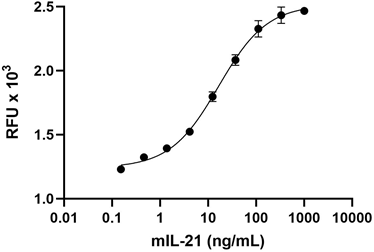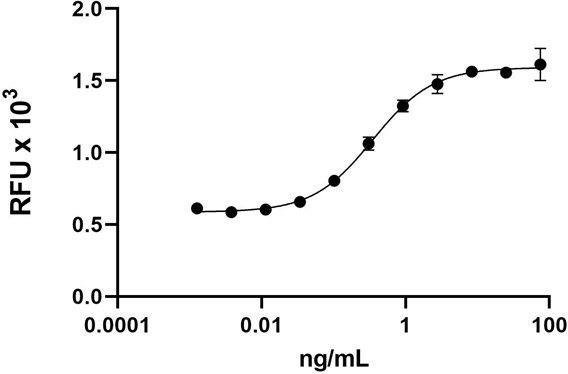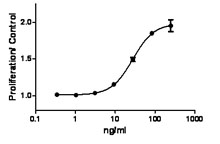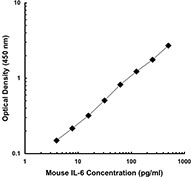- Regulatory Status
- RUO
- Other Names
- Interleukin-6, B cell stimulating factor-2 (BSF-2), Cytotoxic T cell differentiation factor (CDF), Hepatocyte stimulating factor (HSF), Hybridoma/plasmacytoma growth factor (HPGF)
- Ave. Rating
- Submit a Review
- Product Citations
- publications
| Cat # | Size | Price | Quantity Check Availability | Save | ||
|---|---|---|---|---|---|---|
| 715202 | 10 µg | £174 | ||||
This product is not available for shipping outside of the United States.
IL-6 is a multifunctional cytokine that can regulate various immune and inflammatory responses. Several studies have suggested a crucial role for IL-6 in angiogenesis. The use of mice deficient in IL-6 (-/-) demonstrated a critical role for this protein in a mouse model of lung angiogenesis. IL-6 has been shown to cause proliferation and migration of systemic endothelial cells in culture. The classical responsiveness to IL-6 is governed by a receptor complex consisting of two membrane-bound subunits, an 80-kD cognate chain (IL-6R) and a ubiquitously expressed 130-kD β-chain receptor (gp130), which acts as the universal signal-transducing element for all IL-6 family cytokines. Alternatively, IL-6 regulation of leukocyte trafficking relies upon signaling via its soluble IL-6R (termed IL-6 trans-signaling). IL-6 plays a major role in regulating neutrophil clearance during acute peritoneal inflammation; as a result of specific downregulation of neutrophil-attracting chemokine (CXCL1/KC) production. IL-6 is a key factor that reciprocally regulates Th17 and FOXP3+ Treg differentiation by inhibition of TGF-β induced FOXP3 and induction of RORγt, a Th17 lineage-specific transcription factor.
Product DetailsProduct Details
- Source
- Mouse IL-6, amino acids Phe25-Thr211 (Accession# NM_031168), was expressed in E. coli.
- Molecular Mass
- The 188 amino acid N-terminal methionylated recombinant protein has a predicted molecular mass of 21.9 kD. The predicted N-terminal amino acid is Met.
- Purity
- >98%, as determined by Coomassie stained SDS-PAGE and HPLC analysis.
- Formulation
- Lyophilized from 0.1% TFA. Carrier-free.
- Endotoxin Level
- Less than 0.1 ng per µg of protein.
- Storage & Handling
- Unopened vial can be stored at -20°C or -70°C. For maximum results, quick spin vial prior to opening. Reconstitute in water to a concentration of 0.1-1.0 mg/ml. Do not vortex. It is recommended to further dilute in a buffer, such as 5% Trehalose, and store working aliquots at -20°C to -80°C. Avoid repeated freeze/thaw cycles.
- Activity
- ED50 is ≤ 0.02 ng/ml, corresponding to a specific activity of ≤ 5 x 107 units/mg as determined by the dose-dependent stimulation of the proliferation of murine 7TD1 cells.
- Application
-
Bioassay
- Product Citations
-
Antigen Details
- Distribution
-
IL-6 is released by activated T cells, B cells, monocytes, macrophages, fibroblasts, epithelial cells, and endothelial cells.
- Function
- Upregulated by IL-1, TNF, PDGF, IFN-β, TNF-α, NGF, IL-17; downregulated by glucocorticoids IL-4, TGF-β
- Interaction
- T cells, B cells, hepatocytes, cholinergic neurons
- Ligand/Receptor
- Heterodimer IL-6Rα (CD126)/IL-6Rβ (CD130, gp130)
- Bioactivity
- Hematopoiesis, antigen-specific immune responses, inflammatory reactions, acute phase reaction
- Cell Type
- Hematopoietic stem and progenitors
- Biology Area
- Angiogenesis, Cell Biology, Stem Cells
- Molecular Family
- Cytokines/Chemokines
- Antigen References
-
1. McClintock JE and Wagner EM. 2005. 99:861.
2. Murakami M. 1993. Science 260:1808.
3. Jones SA, et al. 2001. J. FASEB. 15:43.
4. Fielding CA, et al. 2008. J. Immunol. 181:2189.
5. Sonderegger I, et al. 2008. Eur. J. Immunol. 38:1833. - Gene ID
- 16193 View all products for this Gene ID
- UniProt
- View information about IL-6 on UniProt.org
Related FAQs
- Why choose BioLegend recombinant proteins?
-
• Each lot of product is quality-tested for bioactivity as indicated on the data sheet.
• Greater than 95% Purity or higher, tested on every lot of product.
• 100% Satisfaction Guarantee for quality performance, stability, and consistency.
• Ready-to-use liquid format saves time and reduces challenges associated with reconstitution.
• Bulk and customization available. Contact us.
• Learn more about our Recombinant Proteins. - How does the activity of your recombinant proteins compare to competitors?
-
We quality control each and every lot of recombinant protein. Not only do we check its bioactivity, but we also compare it against other commercially available recombinant proteins. We make sure each recombinant protein’s activity is at least as good as or better than the competition’s. In order to provide you with the best possible product, we ensure that our testing process is rigorous and thorough. If you’re curious and eager to make the switch to BioLegend recombinants, contact your sales representative today!
- What is the specific activity or ED50 of my recombinant protein?
-
The specific activity range of the protein is indicated on the product datasheets. Because the exact activity values on a per unit basis can largely fluctuate depending on a number of factors, including the nature of the assay, cell density, age of cells/passage number, culture media used, and end user technique, the specific activity is best defined as a range and we guarantee the specific activity of all our lots will be within the range indicated on the datasheet. Please note this only applies to recombinants labeled for use in bioassays. ELISA standard recombinant proteins are not recommended for bioassay usage as they are not tested for these applications.
- Have your recombinants been tested for stability?
-
Our testing shows that the recombinant proteins are able to withstand room temperature for a week without losing activity. In addition the recombinant proteins were also found to withstand four cycles of freeze and thaw without losing activity.
- Does specific activity of a recombinant protein vary between lots?
-
Specific activity will vary for each lot and for the type of experiment that is done to validate it, but all passed lots will have activity within the established ED50 range for the product and we guarantee that our products will have lot-to-lot consistency. Please conduct an experiment-specific validation to find the optimal ED50 for your system.
- How do you convert activity as an ED50 in ng/ml to a specific activity in Units/mg?
-
Use formula Specific activity (Units/mg) = 10^6/ ED50 (ng/mL)
 Login / Register
Login / Register 












Follow Us